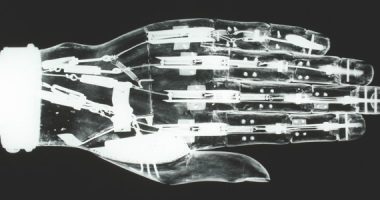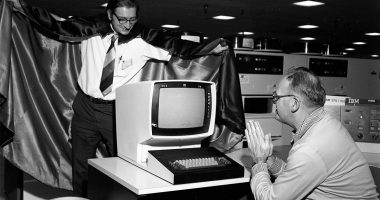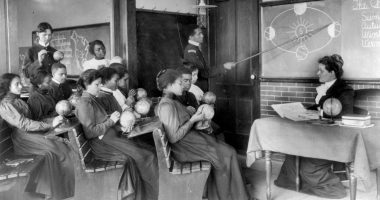
Puente de los Franceses, Madrid
The history of the Internet is an open process, a story in progress. It is impossible to say exactly when it began, and it cannot be attributed to a single inventor. The Network of Networks is the result of numerous scientific and technological advances, of the development of computer languages, of the formulation of different media theories, of the creation, disappearance and resurgence of enterprises such as digital services companies that have woven the Net into what it is today.
The crucial influence of the Internet on every aspect of our lives and on the type of society we are creating make it essential for us to continue to deepen and expand our understanding of it: the wonders that it has made possible and those that it promises, but also the evident dangers of falling into uncritical fascination, or of intellectual surrender in the face of the complexity of the factors that come together in its evolution. For this reason, we would be well advised to accept that the history of the Internet remains open in the light of new disciplines such as network theory, digital humanities, media archaeology, media ecology, etc. And to realise that its timeline is made up of familiar milestones, but also includes huge gaps in our knowledge and reflection. Hence the need to consider the Internet as an expanding universe, with its micro and macro extinctions and the birth of new species. A story that we are all creating together – a collective narrative that should aim towards achieving increasingly democratic, distributed access to knowledge, beyond the decisive influence of scientists, technocrats, governments and corporations.
Others have already tackled the challenge of a historiographical exercise of this kind, including more educational projects such as The history of the Internet in a Nutshell (Six Revisions, 2009) and When was the Internet invented? A people’s History of the Internet (The Guardian, 2009), and other approaches such as Updating the history of web technologies & browsers (Vizzuality, 2012), a visualisation of web technologies and browsers, The Big internet Museum (2011), an online museum of Internet milestones that opens 24/7, and the Internet Hall of Fame’s Living History Timeline (Internet Society, 2012) a timeline that focuses on people who have contributed to the progress of the Net. Each of them do it differently.
And now we have started our own version, which is not by any means exhaustive but is simply a point of departure for an Open Map of the History of the Internet, and which welcomes all of your contributions.
1822 // Charles Babbage designs the first mechanical computer.
1848 // George Boole invents Boolean algebra.
1880 // Alexander Graham Bell invents the telephone.
1934 // Paul Otlet, who is considered to be one of the fathers of “documentation” and was obsessed with classifying all of the world’s knowledge, publishes Radiated Library, a book that anticipates computers and the Internet.
1937 // Alan Turing develops the theoretical concept of the modern computer, and later develops software. He is also considered to be the father of artificial intelligence.
1945 // Vannevar Bush imagines the “Memex”, a microfilm reader with a structure that is analogous to that of the World Wide Web.
1959 // Paul Baran, along with Donald Davies and Leonard Kleinrock, is one of the promoters of packet switched computer networks as a survival strategy for the North American communications network in the event of nuclear attack.
1963 // Douglas Engelbart invents and patents the first computer mouse.
1965 // Andries van Dam and Ted Nelson define the concepts of hypertext and hypermedia.

The first Interface Message Processor (IMP), used to interconnect participant networks to the ARPANET.
1968 // Computer scientists Vinton Cerf and Robert Kahn design TCP/IP protocols (Transmission Control Protocol/Internet Protocol) to connect computers in the military network ARPANET, the precursor of today’s Internet.
1968 // Marshall McLuhan coins the term “global village” to describe the human interconnectivity generated by electronic communications media on a global scale.
1969 // The first computer link-up transmission takes place over a dialup telephone line between UCLA and Stanford universities.
1969 // A group of employees from Bell Laboratories at AT&T start to develop UNIX, an operating system that is not a free software project but is extremely stable.
1971 // Michael Hart launches Project Gutenberg, a global effort that aims to make public domain books and documents available in a wide range of digital and eBook formats. It is sometimes considered the birth of the eBook.
1972 // Ray Tomlinson creates the first e-mail protocol and becomes the first person to send an e-mail.
1973 // The Xerox Alto mini computer is created. It is the first step towards the development of personal computers (PC).
1975 // Altair produces the first microcomputer. This same year, Bill Gates and Paul Allen found the Microsoft Corporation.
1975 // The Jargon File. The New Hackers Dictionary begins to compile hacker slang from computer programming cultures.
1976 // Research carried out by Whitfield Diffie and Martin Hellman on a series of mathematical functions leads to the development of a new theory of cryptography that makes secure e-commerce possible.
1976 // Steve Jobs and Steve Wozniak found the Apple Computer Company in their garage. The following year they create the first personal computer with colour graphics.
1978 // The first magnetic tape is developed in the USA.
1978 // Gary Thuerk sends the first unsolicited bulk e-mail message (later known as spam) to 393 California Arpanet users.
1980 // IBM hires Paul Allen and Bill Gates to create an operating system for a new PC, and they develop DOS.
1982 // The writer William Gibson coins the term “cyberspace” in his short story “Burning Chrome” and later popularises it in his novel Neuromancer (1984).
1982 // Introduction of SMTP (Simple Mail Transfer Protocol).
1983 // Richard Stallman launches the GNU project to create a Unix-compatible operating system composed entirely of free software.
1984 // The Domain Name System (DNS) is implemented, introducing seven domains for the first time: .com, .edu, .gov, .mil, .net, .org, .int

HTML code.
1990 // A group of physicists from CERN led by Tim Berners-Lee develop HTML programming language and, in 1991, they create the prototype of the World Wide Web, using the infrastructure of the to query remote files through texts linked to other files.
1991 // Saskia Sassen writes Global Cities, a book that explores the fact that the new powers are based on global information architectures and symbolic production.
1991 // Linus Thorvald starts working on the LINUX kernel, the beginning of open source software.
1992 // As Bill Clinton’s vice-president, Al Gore, the instigator of the legislation that brought about ARPANET, implements policies for the development of information superhighways that favour interconnection between places, people, and terminals.
1993 // Tim Berners-Lee posts weekly research updates on his personal website What’s new in ‘92, creating what is often considered to be the first blog. It isn’t until 1997 that Jorn Barger officially baptises them “weblogs”.
1993 // Mosaic, the first web browser, is launched.
1994 // Tim Berners-Lee creates the World Wide Web Consortium (W3C), an international community that develops open standards to guide the long-term growth of the Web.
1994 // WebCrawler, the first full search engine, is created.
1994 // Jerry Yang and David Filo, two graduate students from Stanford University co-found Yahoo! an Internet portal that offers a web directory and related services.
1995 // Java is created, Jeff Bezos founds Amazon, Pierre Omindyar launches EBay and Jack Smith and Sabeer Bhatia create Hotmail.
1996 // John Perry Barlow publishes the Declaration of the Independence of Cyberspace, a manifesto that defends the Internet as a new political space.
1996 // Larry Page and Sergey Brin, two Computer Science PhD students from Stanford University, create a more efficient search engine called Google, which ranks the results according to the number of hits and the importance of the page they link to.
1997 // RSS (Really Simple Syndication), a format for sharing content with subscribers, is launched.
1997 // The Institute of Electrical and Electronic Engineers (IEEE), chaired by Vic Hayes, creates standard 802.11 which allows the use the microwave spectrum to transmit Internet data (Wi-Fi).
1998 // Sergei Brin and Larry Page found Google Inc.
1999 // Auto-ID Center develops the concept of the Internet of Things, which in computing terms refers to a network of interconnected objects from daily life.
1999 // Shawn Fanning, John Fanning and Sean Parker create Napster a filesharing system that popularises distributed peer-to-peer (P2P) architecture.
1999 // Peter Thiel and Max Levchin found PayPal.
1999 // Nokia releases the 7110, the first mobile phone that can connect to the Internet using the Wireless Application Protocol (WAP) browser, at a maximum data transfer speed of 9.6 kilobits per second. Websites adapted for mobiles immediately start to appear online.
2000 // The Wireless Ethernet Compatibility Alliance (WECA) begins using the Wi-Fi® trademark to certify Wi-Fi products that conform to interoperability standard IEEE 802.11b. It guarantees that all electronic equipment that displays the Wi-Fi logo can connect to each other wirelessly, regardless of the manufacturer.
2000 // Social movements begin to appear in defense of net neutrality as one of the fundamental principles of the Internet, based on treating all data equally.
2001 // The first third generation mobiles (3G) are tested in Japan.
2001 // Lawrence Lessig sets up Creative Commons, a non-profit organisation that works towards reducing legal barriers to creativity through legislative changes and new technologies, allowing authors the freedom to decide the conditions under which they share their work online.
2001 // Wikipedia is created.
2003 // During the Gulf War, Iraqi architect Salam Pax publishes a blog in which he describes things that are happening on the streets of Baghdad and are not being reported in the media. Media outlets such as the BBC, Reuters and The Guardian quote him as a reliable source, sparking a boom of the blog phenomenon.
2003 // Nokia releases the 6650, the first 3G compatible mobile phone.
2004 // Adam Greenfield publishes an article in which he coins the term “ubiquitous computing” to refer to the way computers are integrated in people’s environments and no longer perceived as discrete objects.
2004 // In the article “The Long Tail” published in Wired, Cris Anderson describes new types of businesses and economic models that have emerged with the Inernet, such as Amazon and Netflix.
2004 // Tim O’Reilly talks about the Web 2.0 concept for the first time in a lecture.
2004 // Marck Zuckerberg creates Facebook to communicate with friends and fellow-students from Harvard University.
2005 // Michel Bauwens publishes the book Peer to Peer and Human Evolution, which expands the P2P “meme” beyond technological culture.
2005 // The term “social network” comes into use with MySpace. Chad Hurley, Steve Chen and Jawed Karim create the online platform Youtube, which allows users to publish and share videos.
2006 // Henry Jenkins publishes Convergence Culture: Where old and new media collide, in which he describes the way technological, industrial, cultural and social relationships have changed in the media flow of our culture.
2006 // Twitter is created.
2006 // The website Wikileaks is set up, although it does not start operating until 2007-2008.
2007 // Rudolf Giffinger publishes Smart Cities – Ranking of European medium-sized cities, in which he puts forward six criteria for classifying smart cities: smart economy, smart mobility, smart environment, smart people, smart living and smart governance.
2007 // The IPhone is launched and smartphones become widespread.
2008 // Clay Shirky publishes Here comes Everybody, in which he looks at collaborative crowdsourcing and explores how new digital media have influenced people’s ability to organise themselves collaboratively without the need for traditional infrastructures.
2008 // Dave Cormier and Bryan Alexanderinvent the term MOOC (Massive Online Open Course) when the enrolment figures for their course Connectivism and Connective Knowledge (CCK08) hits almost 2300 students.
2010 // More tablets that can connect to the Internet (iPad, Samsung Galaxy Tab, ebook or similar) are launched on the market.
2011 // Greenpeace publishes the report “How Dirty is your Data”, which condemns the environmental footprint of large Telecommunications and Internet corporations.





Efraín Foglia | 20 August 2013
Considero que hay un vacío importante al no documentar-detallar el salto contemporáneo del Internet por cable, al Internet móvil.
Con este cambio se generaron nuevas prácticas culturales y sociales que nos han llevado al actual uso de Internet, que se basa en mayor medida en dispositivo portátiles, más que en ordenadores de sobremesa. Esto sin mencionar el giro económico de las corporaciones hacía la movilidad.
Este salto se generó a nivel tecnológico en la Universidad de Delf de la mano de Vic Hayes quién implementó el protocolo IEEE 802.11, responsable de la transmisión de Internet a través del espectro radioeléctrico (WiFi)
http://en.wikipedia.org/wiki/Vic_Hayes
Gracias por esta interesante línea de tiempo que han desarrollado.
Saludos
Equip CCCB LAB | 20 August 2013
Hola Efraín, Gracias por tu aporte. Tienes razón, el salto al Internet móvil ha supuesto otro salto más adelante. Dános un poco de tiempo y lo incorporamos al post.
MariJo | 29 January 2014
Falta Ada Byron o Ada Lovelace, la primera programadora de la máquina de Charles Babbage.
http://ca.wikipedia.org/wiki/Ada_Lovelace
Equip CCCB LAB | 29 January 2014
Tens raó! En breu ho incorporem!
Just avui publiquem un post sobre algoritmes on apareix ella.
Valentina Montero | 01 February 2014
Sería bueno incluir experiencias periféricas a los centros de poder. Como el proyecto Cybersyn que se comenzó a implementar en Chile en 1971, concebida como una suerte de internet socialista, centralizada por el Estado y que ofrecería posibilidades tan vanguardistas y utópicas como “entregar a la gente la posibilidad de tener una conexión a distancia y en tiempo real con políticos y administradores debatiendo decisiones de gobierno y así participar democráticamente en las decisiones”
http://es.wikipedia.org/wiki/Cybersyn
Equip CCCB LAB | 03 February 2014
Muchas gracias por tu aporte Valentina. Lo incluimos en breve.
Leave a comment